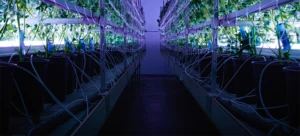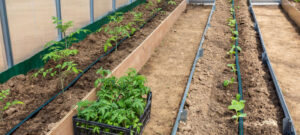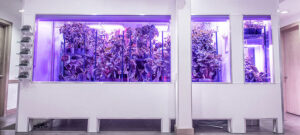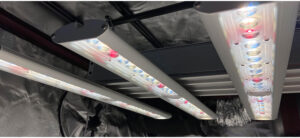Discover Premier Grow Lights for Optimal Plant Growth
Explore the extensive selection of top-tier grow lights at Hydrobuilder.com, each carefully designed to boost indoor plant growth. Whether you're embarking on indoor gardening with your first fluorescent grow light, considering an upgrade to sophisticated CMH or LED grow lights, or a commercial grower in search of high-output, energy efficient commercial grow lights, Hydrobuilder.com offers unbeatable solutions at competitive prices.
The Essential Role of Indoor Plant Lights in Promoting Healthy Growth
If you're new to indoor gardening, the pivotal role of indoor grow lights in fostering healthy plant growth may not be immediately evident.
While outdoor gardens thrive under natural sunlight, which helps plants reach their full growth potential, indoor gardens depend on an alternative light source. Indoor grow lights provide the necessary spectrum and intensity to support plant life in spaces like garages, closets, or spare rooms, effectively replicating the sun's energy indoors to ensure plants flourish 24 hours a day, all year round.
Exploring the Variety of Indoor Plant Grow Lights
The landscape of indoor plant lighting has significantly evolved from traditional incandescent bulbs to include a variety of sophisticated options. Today, four primary types of grow lights are commonly utilized:
Choosing the right grow light for your indoor garden or grow tent involves considering your budget, your specific objectives, and the types of plants you wish to cultivate. We will explore each lighting technology's benefits and limitations to help you make the best choice for your gardening needs.
Selecting the Perfect Grow Light Type for Your Indoor Garden
Our diverse range of grow lamp varieties offers unique benefits tailored for indoor gardening. Selecting the ideal grow light for your indoor plants hinges on the specific conditions of your grow space and your budgetary considerations.
Advantages of Fluorescent Grow Light Fixtures for Indoor Gardens
Fluorescent lighting is a favorite among novice gardeners for its cost-effectiveness, minimal heat output, and ease of use. Both Compact Fluorescent Grow Lights (CFL) and Fluorescent T5 lights are well-suited for small-scale and economical growers. All our fluorescent solutions are designed for 120-volt systems, ensuring compatibility with standard household outlets.
Pros:
- Economical upfront cost
- Low heat emission
- Ideal for confined spaces as they perform best when placed close to the foliage
Cons:
- Less intense than other grow light options
Maximizing Plant Growth with MH & HPS Grow Lights
HID (High-Intensity Discharge) grow lights are highly regarded in horticulture for their effectiveness, setting the standard with their superior watt-to-lumen output and full spectrum grow light capabilities. These systems require three critical components: a bulb, ballast, and reflector, which contribute to their upfront cost and complexity.
HID lighting is available in two primary varieties: Metal Halide (MH) and High-Pressure Sodium (HPS). MH lamps emit a cool, blue light ideal for the vegetative stage, while HPS lamps offer a warm, red light spectrum, perfect for the flowering phase.
Reflectors play a crucial role in maximizing efficiency, as HID lamps produce a wide light spread. These hoods help to refocus lost light back onto the plants, allowing for customizable light distribution tailored to different plant shapes and sizes.
Pros:
- High-intensity, efficient lighting
- Cost-effective, often sold as complete kits
- Adjustable wattage with dimmable ballasts to manage light intensity and conserve energy
- Compatible with standard 120V or 240V outlets
Cons:
- Dependence on specific components for operation (hood & ballast)
- Considerable heat production, requiring effective heat management strategies
- Necessity for greater spacing between lights and plants
- Need for regular bulb replacement every 1-2 years
Double-ended (DE) grow lights significantly enhance both light quality and quantity over single-ended (SE) grow lights, providing a 10-30% increase in light intensity and PAR (Photosynthetically Active Radiation) output. DE lamps are also sturdier and boast a longer lifespan than traditional SE bulbs.
For a comprehensive guide on the best HPS grow lights available, visit our detailed resource to aid your decision-making process.
Ceramic Metal Halide (CMH) Fixtures: Optimal for Indoor Plant Health
Ceramic Metal Halide (CMH) or Light Emitting Ceramics (LEC) lights are an advanced version of HID technology, featuring a ceramic arc tube for superior performance over quartz. CMH fixtures are user-friendly, often coming with integrated ballasts and reflectors, and they connect easily to standard 120V or 240V household outlets.
Explore our review of The Best CMH Lights Of The Year for tailored recommendations. Here are the advantages and challenges of this technology:
Pros:
- High lumen and PAR output for optimal plant growth
- Energy efficient and emits less heat
- Durable bulbs that maintain brightness longer than traditional HIDs
- Provides a natural full spectrum grow light, simplifying the monitoring of indoor plant health
Cons:
- More restricted light coverage area compared to traditional HIDs
- Higher initial cost than some alternatives
LED Grow Light Fixtures: Pioneering Indoor Plant Cultivation
LED grow lights are at the forefront of indoor plant cultivation technology, with many top growers worldwide switching to LED due to its cost-effectiveness and advanced design.
As LED technology progresses, it competes strongly against HID lights in both commercial and residential growing environments. LEDs are compact, eliminating the need for additional reflectors, and come in diverse spectrum options to accommodate different growth stages.
Pros:
- Remarkably low heat output
- Highly efficient in terms of light output per watt
- Cost-effective over the long term with extended durability and energy savings
- Flexible lighting options from full-spectrum to tunable spectrum LEDs
Cons:
- Initial costs are higher
- Complexities in choosing the correct light spectrum and diode colors
- Generally recommended to be placed at least 24 inches above the plants
Essential FAQs on Indoor Plant Lights for Optimal Growth
Starting your indoor gardening journey? We've gathered the most frequently asked questions about indoor plant grow light fixtures to help you master indoor gardening effortlessly.
What is the Optimal Daily Duration for Grow Lights in Indoor Plant Growth?
For vegetative growth, we recommend a minimum of 18 hours of light, followed by 6 hours of darkness for robust plant development. Continuous 24-hour lighting may further accelerate vegetative growth. During the flowering stage, simulating the natural environment by providing 12 hours of light and 12 hours of darkness can promote the production of large, healthy buds.
Should I Turn Off The Indoor Grow Light At Night?
The need to turn off your grow light at night depends on the specific light requirements of the plant species. Some plants thrive with 6-8 hours of light per day, while others prefer continuous light exposure. Using a timer or controller can automate and simplify managing light cycles.
Can I Use Regular Light Bulbs to Grow Plants?
While common household or shop lights support basic plant growth, they do not offer the full spectrum needed for optimal development. Indoor plants generally need both blue light and red light wavelengths for healthy growth, making specialized grow lamps a better choice for horticultural endeavors.
What Is The Best Hydroponic Grow Lamp For Plants?
The selection of grow lamps for hydroponically grown plants is vast. Although hydroponic systems use similar lighting to soil-grown plants, our extensive range ensures you find the perfect fit for your setup, be it DWC, Ebb and Flow, or other hydroponic methods.
Are Grow Lights Bad For Your Eyes?
Extended exposure to full spectrum grow lights can be harmful to your eyes. LEDs and HIDs, in particular, are very intense, so wearing specialized grow room glasses and eyewear is advisable during prolonged use.
Should I Consider An Indoor Grow Light Mover?
Adding a grow light mover to your setup can greatly improve canopy penetration and streamline your growing operations. Equipped with a motor system and rail, these movers optimize light distribution across your plants, making them a solid investment for dedicated gardeners.
What Is The Ideal Light Colors for Vegetative and Flowering Stages?
Specific light spectrum colors are crucial for different plant growth stages. Metal halide lights emit blue light, ideal for the vegetative stage, while High-Pressure Sodium lights emit a red light spectrum, which is beneficial for flowering plants.
What Is the Color Rendering Index Of Plant Lights For Indoor Growing?
The Color Rendering Index (CRI) is essential for accurately assessing the light spectrum emitted by grow lamps, facilitating the right choice for indoor plant cultivation.
Can A Plant Grow Light Reflector Really Help?
A high-quality full spectrum grow light reflector is key to maximizing light efficiency, significantly improving your setup's performance. Reflectors focus more light towards your plants, enhancing their growth and overall health.
How do I Decide on the Right Wattage for Indoor Plant Grow Lamps?
The ideal wattage for your grow lamps depends on the types of plants and the space available. For detailed guidance, check our grow light coverage calculator to find the perfect match for your indoor garden.
Why Choose Hydrobuilder for Your Indoor Plant Grow Lights?
Hydrobuilder is the top choice for experienced growers worldwide because of our unmatched selection of high-quality indoor plant grow lights. Experience professional-grade technology at competitive prices and benefit from our industry-leading customer service. As your complete gardening superstore, we offer everything from grow tent kits to nutrients and harvest supplies. Visit our learning center for more insights on indoor grow light fixtures, or contact our knowledgeable staff at 888-815-9763!






